If you’re in the market for a paddle board, the first question you’ll be faced with is whether you want an inflatable SUP board or a hard paddle board. Both can offer superb performance, but picking the right one depends on what type of activity you will be using it for.
Let’s take a look at how inflatable and non inflatable paddle boards compare. This inflatable paddle board vs solid board guide will go over the features of each and how they impact you on the water, allowing you to pick the best paddle board for your needs.
Inflatable Paddle Boards vs Hard Boards, Know the Difference
If you’re looking at getting a new paddle board, one of the first questions to consider is whether or not you want an inflatable or hard paddle board. If you’re used to using one over the other, don’t write off the other one too quickly.
Today, both inflatables and hard boards are popular options offering an equal level of performance, stability, and ease of use. Let’s go over some of these differences.
Inflatable SUP Features
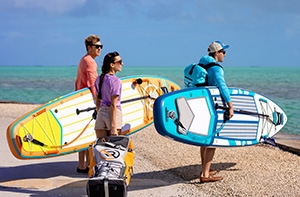
Inflatables have the really awesome feature of being lightweight, portable, easy to pack, and easy to store. Inflatable paddle boards have come so far over the past couple of years, that they can often be indecipherable from traditional epoxy boards in terms of their durability and build quality.
Inflatables are made out of a really tough interior material that consists of thousands of tiny fabrics connecting the bottom to the top of the board. This type of construction is called drop stitch technology. It’s what allows an iSUP to be inflated at a high PSI so that it offers optimal rigidity, as it effectively anchors the top and bottom ‘layers’ of the paddle board together, so that it will not bulge out or tear apart at the seams when inflated.
Inflatables are also often layered with a really durable rubber and PVC material for added durability. You will usually find that inflatables also feature a soft padded deck for added comfort too.
At a glance, the standout features of an inflatable board are:
- Lightweight
- Easy to store and transport (when deflated)
- Durable
- Wider bases with a consistent thickness, offering great stability
Rigid Board Features
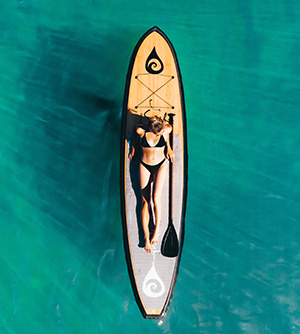
Unlike inflatables, hard SUP boards are a little more cumbersome to travel with, because they obviously can’t be deflated down into a packable unit.
Hard paddle boards can be made out of a variety of materials including carbon fiber, epoxy resin, fiberglass, wood, and PVC or plastic. Because of the range of material options, hard boards are durable – but that does not mean they are moreso than their inflatable counterparts (more on that later).
There will also be a range of size options as well. Typically, however, hard boards tend to be longer, narrower, and more tapered at the edges than inflatables
Their varying sizes and shapes also allow them to be used in a range of activities. Paddlers who are looking for speed, maneuverability, and other recreational activities might prefer to go with a hard board. Their long, slender shape makes them well-suited for SUP racing, for example.
With hard paddle boards, you will typically find the following features:
- Varying material options are great for a variety of paddlers
- Hard exteriors make them very durable
- Longer, narrower constructions allow paddlers to pick up speed easily
- Tapered edges make maneuverability and sharp turns easier
Are Inflatable Paddle Boards Durable?
While a hard board might seem more durable than an inflatable board, that’s not always the case. Inflatable paddle boards, especially ones that are well built, are incredibly durable. Some paddlers will even go so far as to say they find inflatables are less easily damaged than rigid boards, because inflatables tend to bounce and flex when they are bumped or scraped.
This means that the very construction of an inflatable allows it to bounce off of objects you may encounter on the water. Because inflatables are really well-built, they aren’t as easy to puncture or tear as you might imagine. A hard board on the other hand will ding or scratch up every time it encounters an object, gets dropped, or dragged.
The upside about hard shells of course is that they are virtually resistant to punctures. Even if you scratch or slightly dent a hard paddle board, it will still perform and keep you afloat on the water.
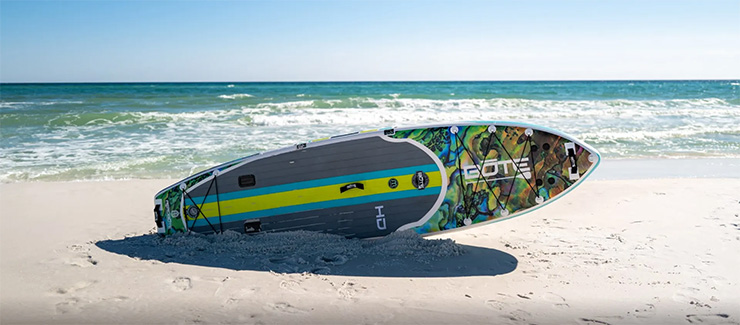
Inflatable vs Hardshell SUP, Which Should I Choose?
Choosing a paddle board is hard as is, but when both inflatables and hard boards are great options to go with, how do you know which is right for you? The answer really boils down to your needs.
The stability and wide decks that are often associated with inflatables make them great options for beginners. On the other hand, narrower constructed hard boards that feature tapered edges are better for paddlers looking for more versatility. Let’s take a closer look at some important features to consider before you make your choice.
Know Your Needs
Before settling on a paddle board, it’s important to consider your needs first. How you want to use the paddle board will determine whether or not you should choose an inflatable or a hard paddle board. Common uses for paddle board include:
- SUP yoga
- SUP fishing
- Light touring
- Catching light rapids
- Racing/speed
- Sea paddling
Best SUP for Recreational Use
Recreational use takes on a couple of different meanings. For example, using a paddle board for SUP yoga can fall under the recreational category, but so too can fishing or paddle boarding over light rapids or in the ocean. Either way, inflatable SUPs are a popular way to go for those who want a general all-purpose paddle board
Inflatable paddle boards tend to be wider and a bit thicker than hard paddle boards. This construction allows them to be a bit more stable,and also affords some onboard storage space for things like fishing gear.
Stability is also key for those who are looking to get started in the world of paddle boarding. A stable board will allow you to practice your balance and get better at controlling and maneuvering the board.
Because of their wider designs, inflatables aren’t always the best when it comes to speed due to their wider noses. Luckily, if you want a speed friendly board, but don’t want to go with a hardshell, in today’s market, there are some quality inflatables that might meet your needs (like the Atoll 11).
And while inflatables tend to be a consistent thickness, there are those models that taper off on the edges. This is a feature that many paddlers who want maneuverability and quick agility on their board look for.
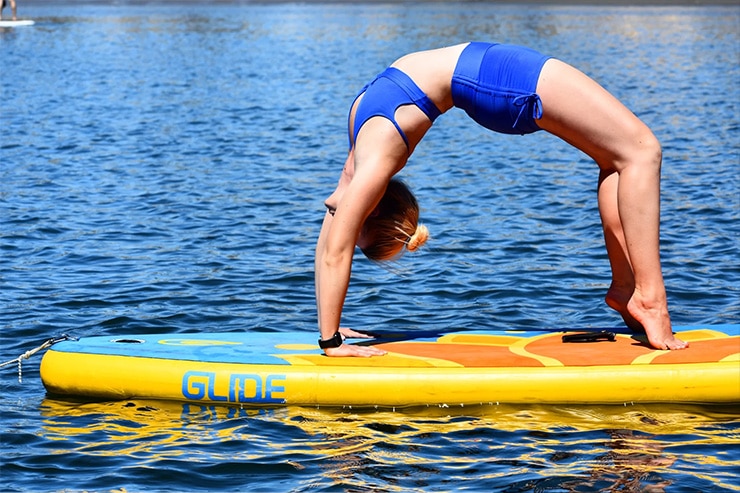
Best SUP for Speed
If speed is your goal while out on the water, then you’ll probably want to opt for an epoxy board or fiberglass board. These types of boards are typically very lightweight and feel so under your feet as you paddle.
These boards are also a lot narrower than their inflatable counterparts. This narrow construction with pointed nose and tail ends allows you to glide through the water rather quickly. It’s usually for these hard paddle boards to also taper a bit at the edges, though narrower boards might not taper off as much as wider boards might.
Best SUP for Touring
If you want a great touring kayak but don’t necessarily require speed, then you can go with either an inflatable or a hard shell. There are many inflatable models for those who want something “all purpose” to tour with. However, hard shells are equally comfortable and suitable for this type of activity.
For touring, paddlers should also consider comfort as you likely will be on the water for a longer period of time. There’s certainly hard boards that feature a padded deck, but comfort is usually a staple feature of inflatable boards.
Inflatables naturally have a cushion surface that offers a little bit of pushback when you stand on it. Unless there is a cushion deck, hard pedal boards typically don’t offer this benefit of comfort.
Inflatables offer Ease of Portability
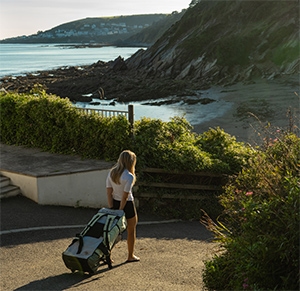
A big aspect when shopping for the right paddle board is whether or not portability will be an issue for you. All you singleton paddlers out there who own a hardboard know how difficult it can be to pull down or lift up and secure your hard paddle board on every outing.
While lifting and securing a hardboard is easier with a partner, you might not always have a partner with you whenever you hit the water. This is when inflatables can come in real handy.
Inflatables have been a game-changer for many because of how portable they are. Inflatables are easy to inflate and set up. When it’s time to go, they are equally easy to pack down, fold up, and store away.
Consider Performance
The way you want your paddle board to perform is another aspect to consider when shopping around. Do you need a paddle board that gives you the ability to turn and lean without fuss? Or do you want something more stable that doesn’t wobble underneath you?
Stability is a key feature for paddlers who don’t want to be overly aggressive on the water. Those looking to enjoy calm touring or a yoga class might want the stability offered by a wide deck inflatable.
On the other hand, paddlers who need a versatile and quick response board might prefer a hard board.
What About the Price?
Price point is another aspect to consider. Luckily, in today’s market, there are so many different paddle board types and styles that there’s a great fit for every budget.
As with any purchase, an expensive board doesn’t necessarily mean it’s the best board for you. Typically, pricier boards tend to have lots of additional features and accessories. that come along with them. Sometimes, these added features are not necessary for the type of paddling you want to do.
When you shop around, be aware of the features you want in your paddle board. When you shop with those features in mind, you are more likely to pick the right board for yourself at a price point that meets your budget.
Do Inflatable SUPs Last as Long as Hard Boards?
You might be surprised to learn that an inflatable paddle board can last just as long – if not longer – than traditional hard or epoxy boards. Or course it’s important to know that the lifespan of an inflatable totally depends on how you take care of it.
Cleaning your paddle board off with fresh water after every use will keep damaging mold and mildew from building up on it. Drying it off properly and then storing it in a cool area free of punctures is also important. Avoiding extended sun exposure and harsh cleaning chemicals are also ways to maintain the integrity of your inflatables material.
Understanding how to clean your inflatable and following your board’s manufacture instructions will ensure your board has a long life span.
Are Inflatable SUP Boards as Stable as Solid Paddle Boards?
Inflatable paddle boards stand to be a lot more stable than their hard counterparts. This is largely because of the thickness of inflatable paddle boards. A 5-6 inch thick paddle board can offer just enough height to give you a really stable platform to stand on. Boards thinner than 5 inches can often feel a bit wobblier, especially if they taper at the edges.
Inflatable paddle boards also tend to be the same thickness all around. Without tapered edges on the sides, your board will rest against the surface of the water without tipping on either side.
If you’re participating in an activity that requires a stable board, an inflatable might be the way to go. Activities including touring, exploring with young children, and even yoga paddle boarding will require you to have a staple board.

Can Inflatable Paddle Boards Be Repaired?
Even in the worst case scenario, if you happen to puncture or tear your paddle board, you can repair it. Most paddle boards will come with a repair kit that will allow you to patch up any holes small sized tears in your paddle board. Unless you are intentionally paddling over ragged rocks, it’s pretty difficult to sustain a large, irreparable tear in your inflatable board.
In those rare cases where you puncture or chip your paddle board right at the seam, it may be a bit more challenging to repair it. However, if you are able to repair it, you’ll significantly extend the life of your board.
Can You Surf on an Inflatable SUP?
Inflatable boards are known for their stability. Because of this, it’s common for them to be used if you’re just getting started in certain activities like surfing.
Paddle boards operate just like a surfboard in that they feature a flat surface that you stand on top of and balance on. Unlike a surfboard, however, paddle boards, especially inflatables may not always feature a slightly curved nose. This lack of curve may keep you from being able to execute quick and agile moves on waves.
However, if you’re looking to do some easy, beginner level surfing, then you could use a paddle board. Just make sure you use a board that is rather narrow, the right length for your size, and able to cut through the water.
The Verdict: Are Inflatable Paddle Boards Better Than Solid Paddle Boards?
Ask any paddlers who have an iSUP and they’ll likely tell you they love their board. The question of whether or not an inflatable paddle board is better than a hard board really depends on the person and their paddling needs.
Overall however, inflatables have become such a popular option because of how easy they are to pack, transport, and store away. If you are just getting started in the world of paddle boarding, inflatables are excellent options to go with. They are lightweight, easy to learn on, and just as fun to use as any other hard paddle board out there.

